Cultural Characteristics Report: New Zealand and China Markets
VerifiedAdded on 2019/12/17
|10
|3143
|427
Report
AI Summary
This report provides a comprehensive analysis of the cultural characteristics of the New Zealand and China markets, focusing on their impact on business operations. It explores various cultural models, including the Iceberg Model and Charles Handy's organizational culture concepts, to understand how culture influences individual behaviors and business processes. The report examines specific cultural elements like symbols, language, region, values, and beliefs, and their relevance to a company like Nestle expanding into these markets. It highlights cultural differences, such as language variations and religious practices, and suggests the application of Hofstede's cultural dimensions to formulate effective marketing strategies. The report emphasizes the importance of understanding cultural nuances for successful business ventures and achieving profitability in diverse markets. The report underscores the impact of cultural factors on business operations and offers insights into developing strategies for success in diverse market environments.
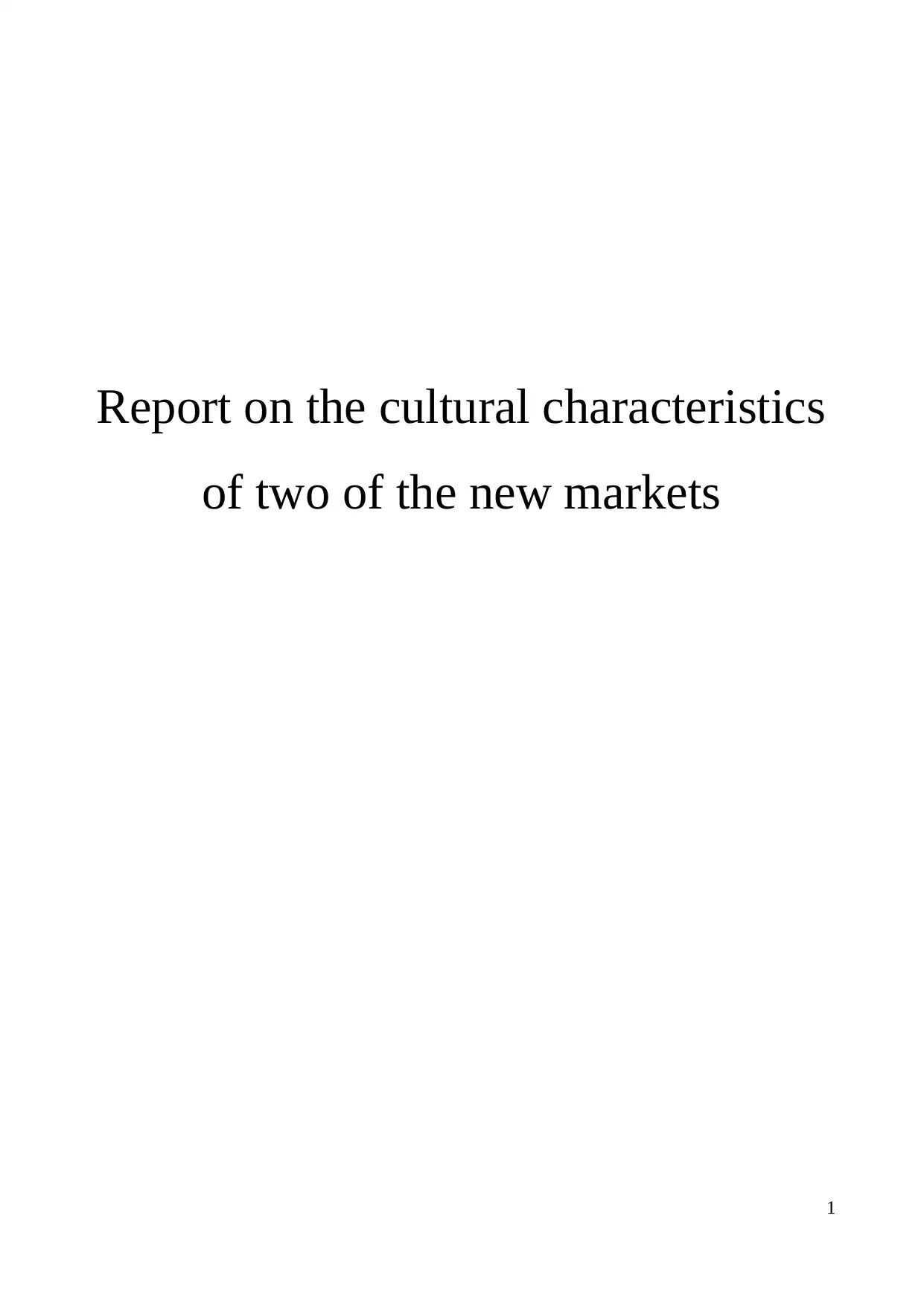
Report on the cultural characteristics
of two of the new markets
1
of two of the new markets
1
Paraphrase This Document
Need a fresh take? Get an instant paraphrase of this document with our AI Paraphraser
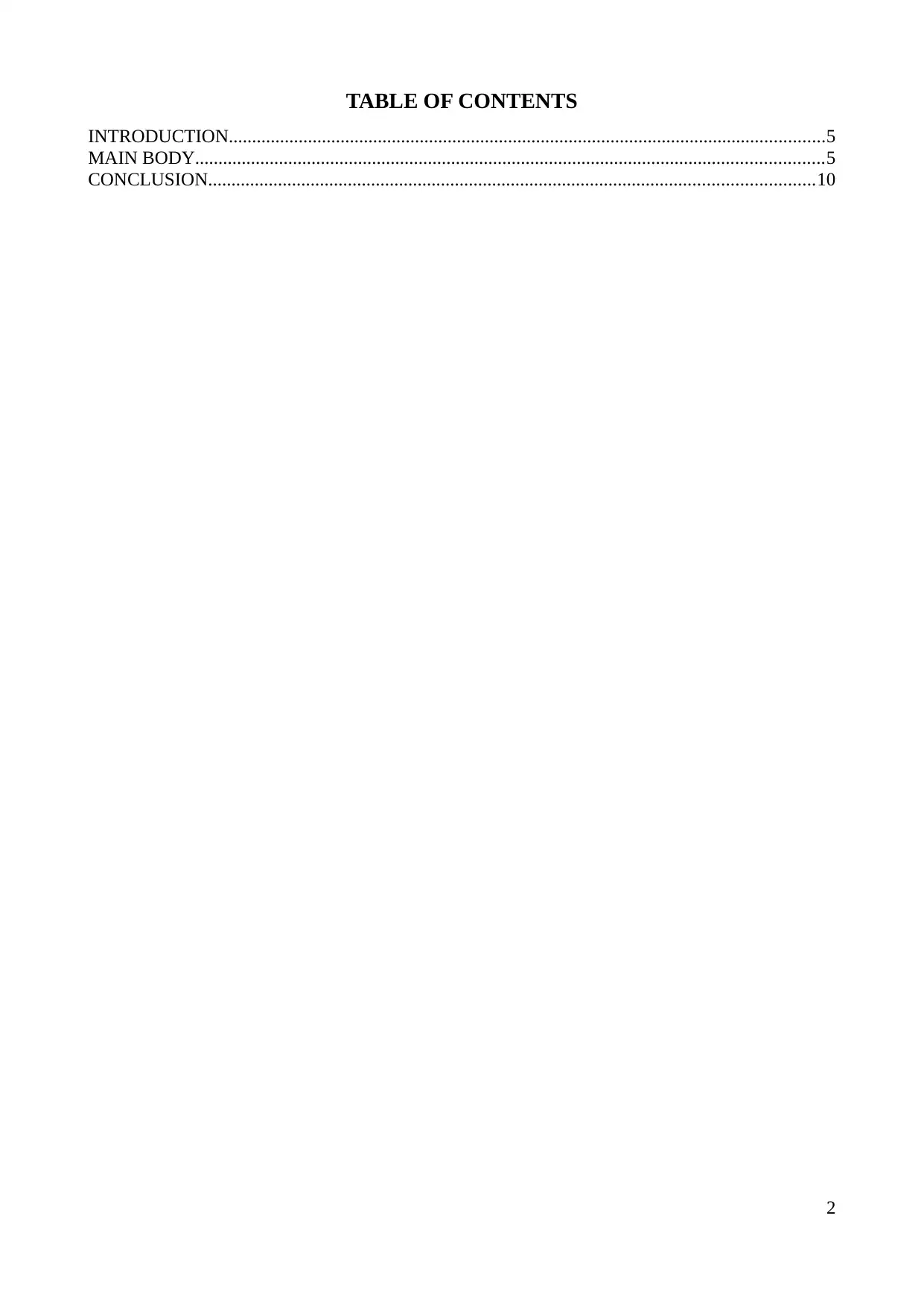
TABLE OF CONTENTS
INTRODUCTION................................................................................................................................5
MAIN BODY.......................................................................................................................................5
CONCLUSION..................................................................................................................................10
2
INTRODUCTION................................................................................................................................5
MAIN BODY.......................................................................................................................................5
CONCLUSION..................................................................................................................................10
2
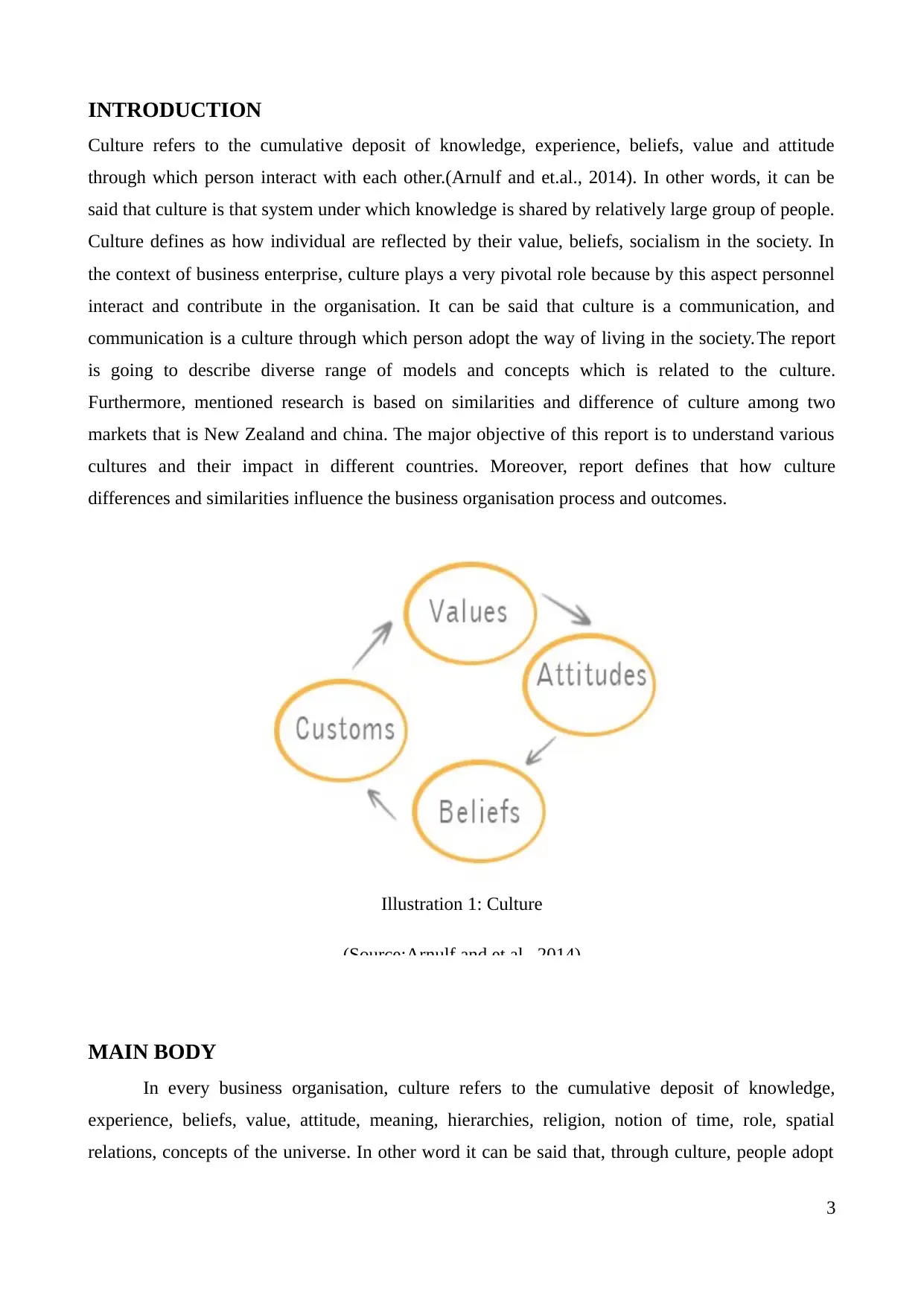
INTRODUCTION
Culture refers to the cumulative deposit of knowledge, experience, beliefs, value and attitude
through which person interact with each other.(Arnulf and et.al., 2014). In other words, it can be
said that culture is that system under which knowledge is shared by relatively large group of people.
Culture defines as how individual are reflected by their value, beliefs, socialism in the society. In
the context of business enterprise, culture plays a very pivotal role because by this aspect personnel
interact and contribute in the organisation. It can be said that culture is a communication, and
communication is a culture through which person adopt the way of living in the society.The report
is going to describe diverse range of models and concepts which is related to the culture.
Furthermore, mentioned research is based on similarities and difference of culture among two
markets that is New Zealand and china. The major objective of this report is to understand various
cultures and their impact in different countries. Moreover, report defines that how culture
differences and similarities influence the business organisation process and outcomes.
MAIN BODY
In every business organisation, culture refers to the cumulative deposit of knowledge,
experience, beliefs, value, attitude, meaning, hierarchies, religion, notion of time, role, spatial
relations, concepts of the universe. In other word it can be said that, through culture, people adopt
3
Illustration 1: Culture
(Source:Arnulf and et.al., 2014)
Culture refers to the cumulative deposit of knowledge, experience, beliefs, value and attitude
through which person interact with each other.(Arnulf and et.al., 2014). In other words, it can be
said that culture is that system under which knowledge is shared by relatively large group of people.
Culture defines as how individual are reflected by their value, beliefs, socialism in the society. In
the context of business enterprise, culture plays a very pivotal role because by this aspect personnel
interact and contribute in the organisation. It can be said that culture is a communication, and
communication is a culture through which person adopt the way of living in the society.The report
is going to describe diverse range of models and concepts which is related to the culture.
Furthermore, mentioned research is based on similarities and difference of culture among two
markets that is New Zealand and china. The major objective of this report is to understand various
cultures and their impact in different countries. Moreover, report defines that how culture
differences and similarities influence the business organisation process and outcomes.
MAIN BODY
In every business organisation, culture refers to the cumulative deposit of knowledge,
experience, beliefs, value, attitude, meaning, hierarchies, religion, notion of time, role, spatial
relations, concepts of the universe. In other word it can be said that, through culture, people adopt
3
Illustration 1: Culture
(Source:Arnulf and et.al., 2014)
⊘ This is a preview!⊘
Do you want full access?
Subscribe today to unlock all pages.

Trusted by 1+ million students worldwide
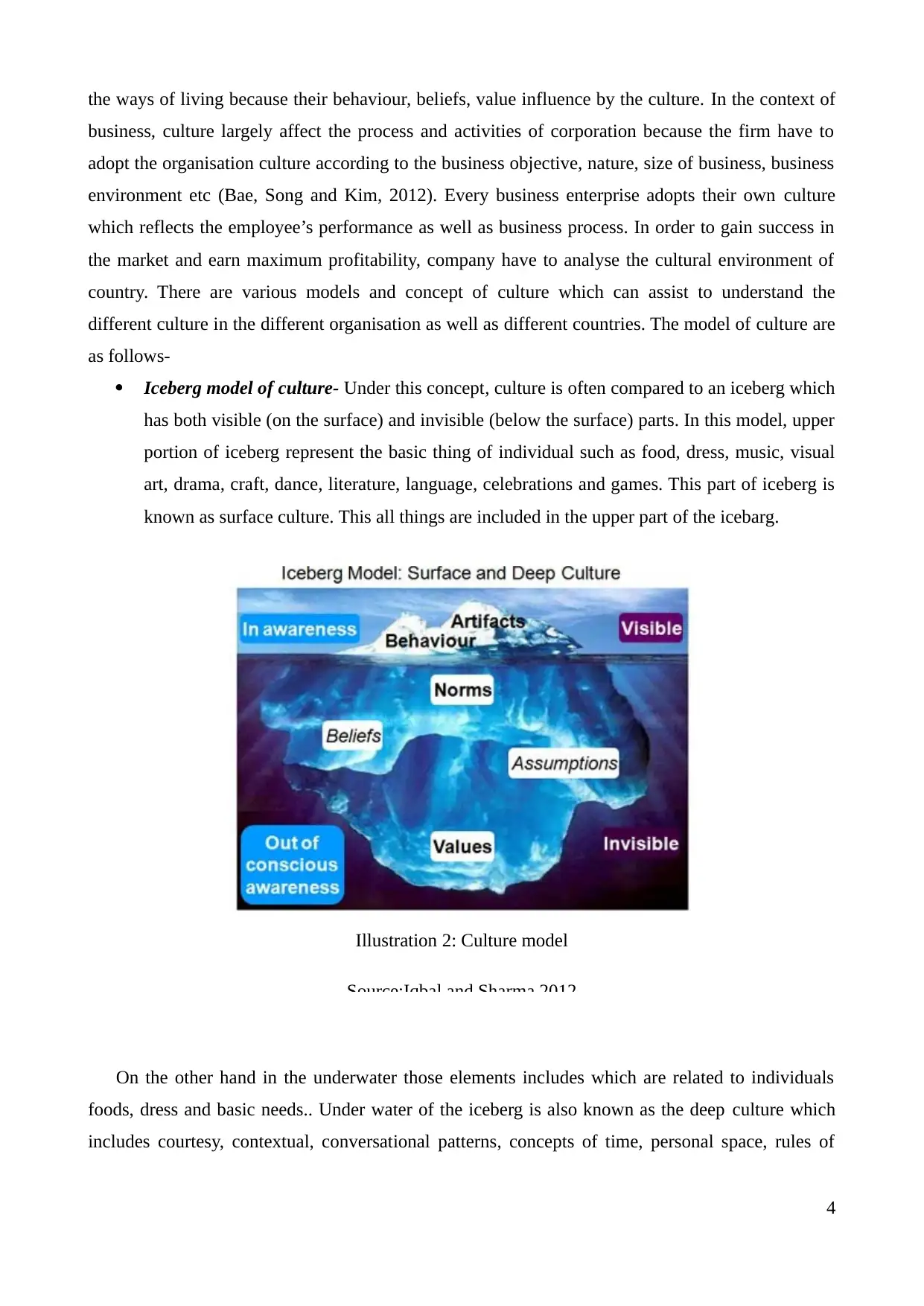
the ways of living because their behaviour, beliefs, value influence by the culture. In the context of
business, culture largely affect the process and activities of corporation because the firm have to
adopt the organisation culture according to the business objective, nature, size of business, business
environment etc (Bae, Song and Kim, 2012). Every business enterprise adopts their own culture
which reflects the employee’s performance as well as business process. In order to gain success in
the market and earn maximum profitability, company have to analyse the cultural environment of
country. There are various models and concept of culture which can assist to understand the
different culture in the different organisation as well as different countries. The model of culture are
as follows-
Iceberg model of culture- Under this concept, culture is often compared to an iceberg which
has both visible (on the surface) and invisible (below the surface) parts. In this model, upper
portion of iceberg represent the basic thing of individual such as food, dress, music, visual
art, drama, craft, dance, literature, language, celebrations and games. This part of iceberg is
known as surface culture. This all things are included in the upper part of the icebarg.
On the other hand in the underwater those elements includes which are related to individuals
foods, dress and basic needs.. Under water of the iceberg is also known as the deep culture which
includes courtesy, contextual, conversational patterns, concepts of time, personal space, rules of
4
Illustration 2: Culture model
Source:Iqbal and Sharma,2012
business, culture largely affect the process and activities of corporation because the firm have to
adopt the organisation culture according to the business objective, nature, size of business, business
environment etc (Bae, Song and Kim, 2012). Every business enterprise adopts their own culture
which reflects the employee’s performance as well as business process. In order to gain success in
the market and earn maximum profitability, company have to analyse the cultural environment of
country. There are various models and concept of culture which can assist to understand the
different culture in the different organisation as well as different countries. The model of culture are
as follows-
Iceberg model of culture- Under this concept, culture is often compared to an iceberg which
has both visible (on the surface) and invisible (below the surface) parts. In this model, upper
portion of iceberg represent the basic thing of individual such as food, dress, music, visual
art, drama, craft, dance, literature, language, celebrations and games. This part of iceberg is
known as surface culture. This all things are included in the upper part of the icebarg.
On the other hand in the underwater those elements includes which are related to individuals
foods, dress and basic needs.. Under water of the iceberg is also known as the deep culture which
includes courtesy, contextual, conversational patterns, concepts of time, personal space, rules of
4
Illustration 2: Culture model
Source:Iqbal and Sharma,2012
Paraphrase This Document
Need a fresh take? Get an instant paraphrase of this document with our AI Paraphraser
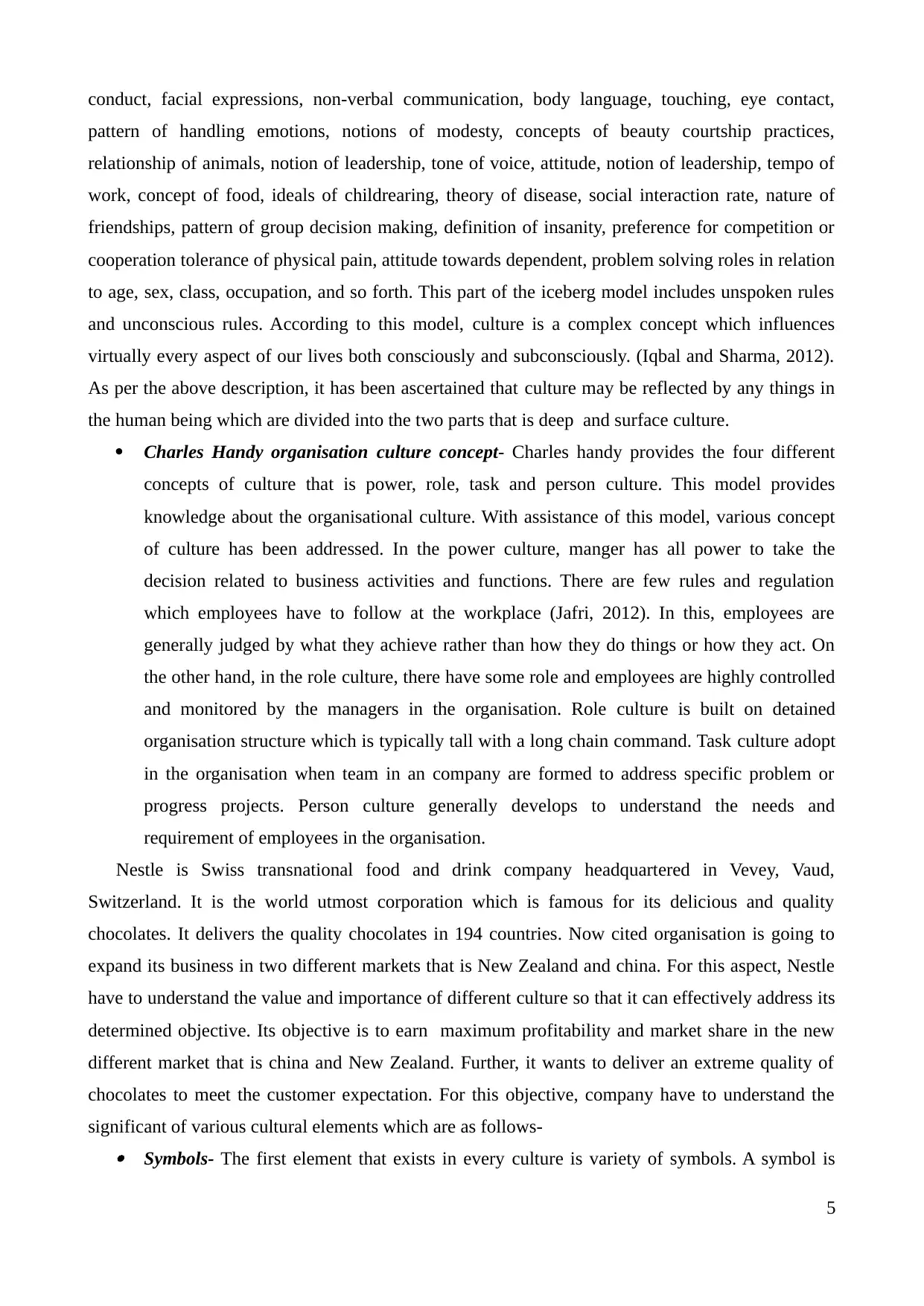
conduct, facial expressions, non-verbal communication, body language, touching, eye contact,
pattern of handling emotions, notions of modesty, concepts of beauty courtship practices,
relationship of animals, notion of leadership, tone of voice, attitude, notion of leadership, tempo of
work, concept of food, ideals of childrearing, theory of disease, social interaction rate, nature of
friendships, pattern of group decision making, definition of insanity, preference for competition or
cooperation tolerance of physical pain, attitude towards dependent, problem solving roles in relation
to age, sex, class, occupation, and so forth. This part of the iceberg model includes unspoken rules
and unconscious rules. According to this model, culture is a complex concept which influences
virtually every aspect of our lives both consciously and subconsciously. (Iqbal and Sharma, 2012).
As per the above description, it has been ascertained that culture may be reflected by any things in
the human being which are divided into the two parts that is deep and surface culture.
Charles Handy organisation culture concept- Charles handy provides the four different
concepts of culture that is power, role, task and person culture. This model provides
knowledge about the organisational culture. With assistance of this model, various concept
of culture has been addressed. In the power culture, manger has all power to take the
decision related to business activities and functions. There are few rules and regulation
which employees have to follow at the workplace (Jafri, 2012). In this, employees are
generally judged by what they achieve rather than how they do things or how they act. On
the other hand, in the role culture, there have some role and employees are highly controlled
and monitored by the managers in the organisation. Role culture is built on detained
organisation structure which is typically tall with a long chain command. Task culture adopt
in the organisation when team in an company are formed to address specific problem or
progress projects. Person culture generally develops to understand the needs and
requirement of employees in the organisation.
Nestle is Swiss transnational food and drink company headquartered in Vevey, Vaud,
Switzerland. It is the world utmost corporation which is famous for its delicious and quality
chocolates. It delivers the quality chocolates in 194 countries. Now cited organisation is going to
expand its business in two different markets that is New Zealand and china. For this aspect, Nestle
have to understand the value and importance of different culture so that it can effectively address its
determined objective. Its objective is to earn maximum profitability and market share in the new
different market that is china and New Zealand. Further, it wants to deliver an extreme quality of
chocolates to meet the customer expectation. For this objective, company have to understand the
significant of various cultural elements which are as follows- Symbols- The first element that exists in every culture is variety of symbols. A symbol is
5
pattern of handling emotions, notions of modesty, concepts of beauty courtship practices,
relationship of animals, notion of leadership, tone of voice, attitude, notion of leadership, tempo of
work, concept of food, ideals of childrearing, theory of disease, social interaction rate, nature of
friendships, pattern of group decision making, definition of insanity, preference for competition or
cooperation tolerance of physical pain, attitude towards dependent, problem solving roles in relation
to age, sex, class, occupation, and so forth. This part of the iceberg model includes unspoken rules
and unconscious rules. According to this model, culture is a complex concept which influences
virtually every aspect of our lives both consciously and subconsciously. (Iqbal and Sharma, 2012).
As per the above description, it has been ascertained that culture may be reflected by any things in
the human being which are divided into the two parts that is deep and surface culture.
Charles Handy organisation culture concept- Charles handy provides the four different
concepts of culture that is power, role, task and person culture. This model provides
knowledge about the organisational culture. With assistance of this model, various concept
of culture has been addressed. In the power culture, manger has all power to take the
decision related to business activities and functions. There are few rules and regulation
which employees have to follow at the workplace (Jafri, 2012). In this, employees are
generally judged by what they achieve rather than how they do things or how they act. On
the other hand, in the role culture, there have some role and employees are highly controlled
and monitored by the managers in the organisation. Role culture is built on detained
organisation structure which is typically tall with a long chain command. Task culture adopt
in the organisation when team in an company are formed to address specific problem or
progress projects. Person culture generally develops to understand the needs and
requirement of employees in the organisation.
Nestle is Swiss transnational food and drink company headquartered in Vevey, Vaud,
Switzerland. It is the world utmost corporation which is famous for its delicious and quality
chocolates. It delivers the quality chocolates in 194 countries. Now cited organisation is going to
expand its business in two different markets that is New Zealand and china. For this aspect, Nestle
have to understand the value and importance of different culture so that it can effectively address its
determined objective. Its objective is to earn maximum profitability and market share in the new
different market that is china and New Zealand. Further, it wants to deliver an extreme quality of
chocolates to meet the customer expectation. For this objective, company have to understand the
significant of various cultural elements which are as follows- Symbols- The first element that exists in every culture is variety of symbols. A symbol is
5
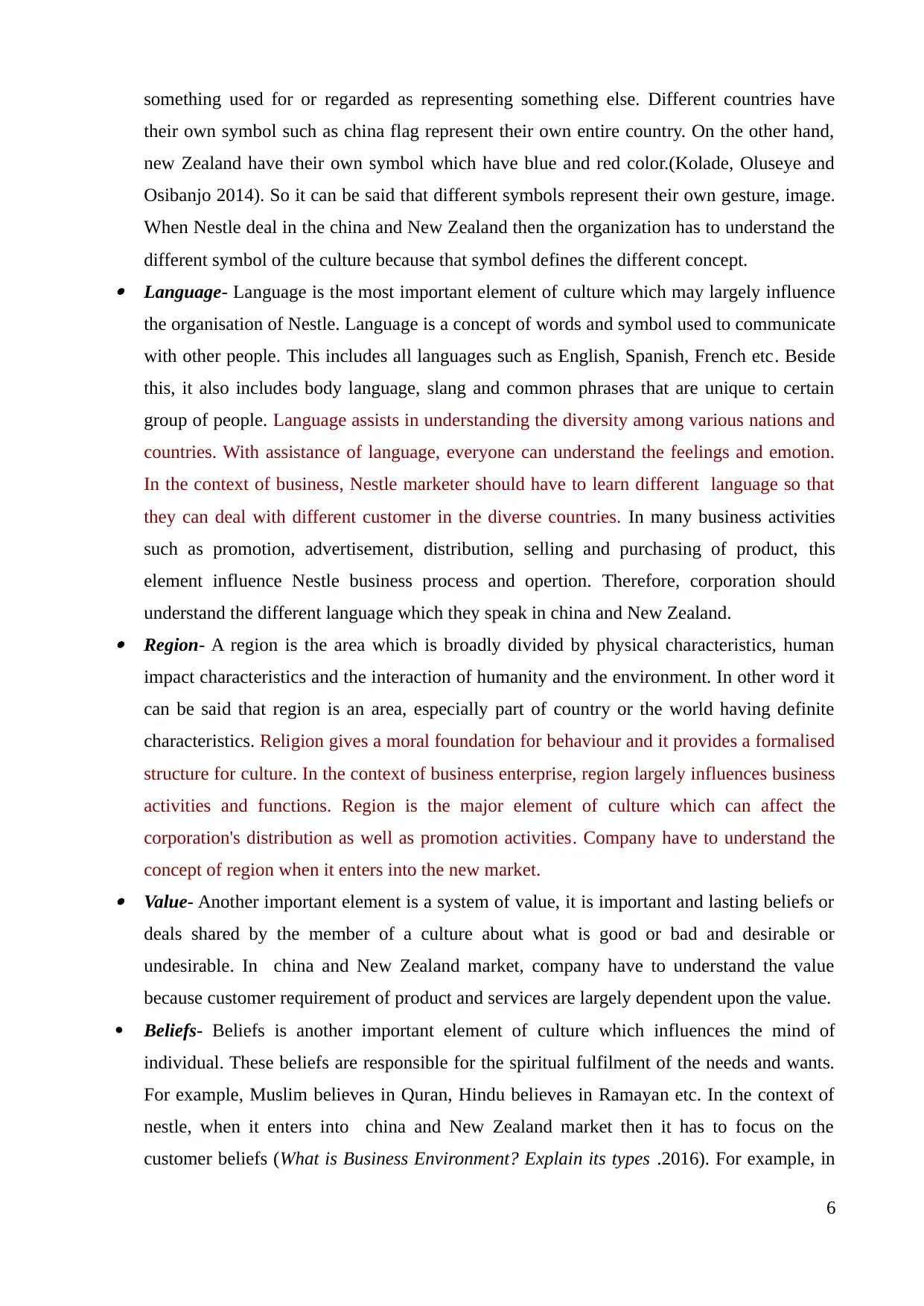
something used for or regarded as representing something else. Different countries have
their own symbol such as china flag represent their own entire country. On the other hand,
new Zealand have their own symbol which have blue and red color.(Kolade, Oluseye and
Osibanjo 2014). So it can be said that different symbols represent their own gesture, image.
When Nestle deal in the china and New Zealand then the organization has to understand the
different symbol of the culture because that symbol defines the different concept. Language- Language is the most important element of culture which may largely influence
the organisation of Nestle. Language is a concept of words and symbol used to communicate
with other people. This includes all languages such as English, Spanish, French etc. Beside
this, it also includes body language, slang and common phrases that are unique to certain
group of people. Language assists in understanding the diversity among various nations and
countries. With assistance of language, everyone can understand the feelings and emotion.
In the context of business, Nestle marketer should have to learn different language so that
they can deal with different customer in the diverse countries. In many business activities
such as promotion, advertisement, distribution, selling and purchasing of product, this
element influence Nestle business process and opertion. Therefore, corporation should
understand the different language which they speak in china and New Zealand. Region- A region is the area which is broadly divided by physical characteristics, human
impact characteristics and the interaction of humanity and the environment. In other word it
can be said that region is an area, especially part of country or the world having definite
characteristics. Religion gives a moral foundation for behaviour and it provides a formalised
structure for culture. In the context of business enterprise, region largely influences business
activities and functions. Region is the major element of culture which can affect the
corporation's distribution as well as promotion activities. Company have to understand the
concept of region when it enters into the new market. Value- Another important element is a system of value, it is important and lasting beliefs or
deals shared by the member of a culture about what is good or bad and desirable or
undesirable. In china and New Zealand market, company have to understand the value
because customer requirement of product and services are largely dependent upon the value.
Beliefs- Beliefs is another important element of culture which influences the mind of
individual. These beliefs are responsible for the spiritual fulfilment of the needs and wants.
For example, Muslim believes in Quran, Hindu believes in Ramayan etc. In the context of
nestle, when it enters into china and New Zealand market then it has to focus on the
customer beliefs (What is Business Environment? Explain its types .2016). For example, in
6
their own symbol such as china flag represent their own entire country. On the other hand,
new Zealand have their own symbol which have blue and red color.(Kolade, Oluseye and
Osibanjo 2014). So it can be said that different symbols represent their own gesture, image.
When Nestle deal in the china and New Zealand then the organization has to understand the
different symbol of the culture because that symbol defines the different concept. Language- Language is the most important element of culture which may largely influence
the organisation of Nestle. Language is a concept of words and symbol used to communicate
with other people. This includes all languages such as English, Spanish, French etc. Beside
this, it also includes body language, slang and common phrases that are unique to certain
group of people. Language assists in understanding the diversity among various nations and
countries. With assistance of language, everyone can understand the feelings and emotion.
In the context of business, Nestle marketer should have to learn different language so that
they can deal with different customer in the diverse countries. In many business activities
such as promotion, advertisement, distribution, selling and purchasing of product, this
element influence Nestle business process and opertion. Therefore, corporation should
understand the different language which they speak in china and New Zealand. Region- A region is the area which is broadly divided by physical characteristics, human
impact characteristics and the interaction of humanity and the environment. In other word it
can be said that region is an area, especially part of country or the world having definite
characteristics. Religion gives a moral foundation for behaviour and it provides a formalised
structure for culture. In the context of business enterprise, region largely influences business
activities and functions. Region is the major element of culture which can affect the
corporation's distribution as well as promotion activities. Company have to understand the
concept of region when it enters into the new market. Value- Another important element is a system of value, it is important and lasting beliefs or
deals shared by the member of a culture about what is good or bad and desirable or
undesirable. In china and New Zealand market, company have to understand the value
because customer requirement of product and services are largely dependent upon the value.
Beliefs- Beliefs is another important element of culture which influences the mind of
individual. These beliefs are responsible for the spiritual fulfilment of the needs and wants.
For example, Muslim believes in Quran, Hindu believes in Ramayan etc. In the context of
nestle, when it enters into china and New Zealand market then it has to focus on the
customer beliefs (What is Business Environment? Explain its types .2016). For example, in
6
⊘ This is a preview!⊘
Do you want full access?
Subscribe today to unlock all pages.

Trusted by 1+ million students worldwide
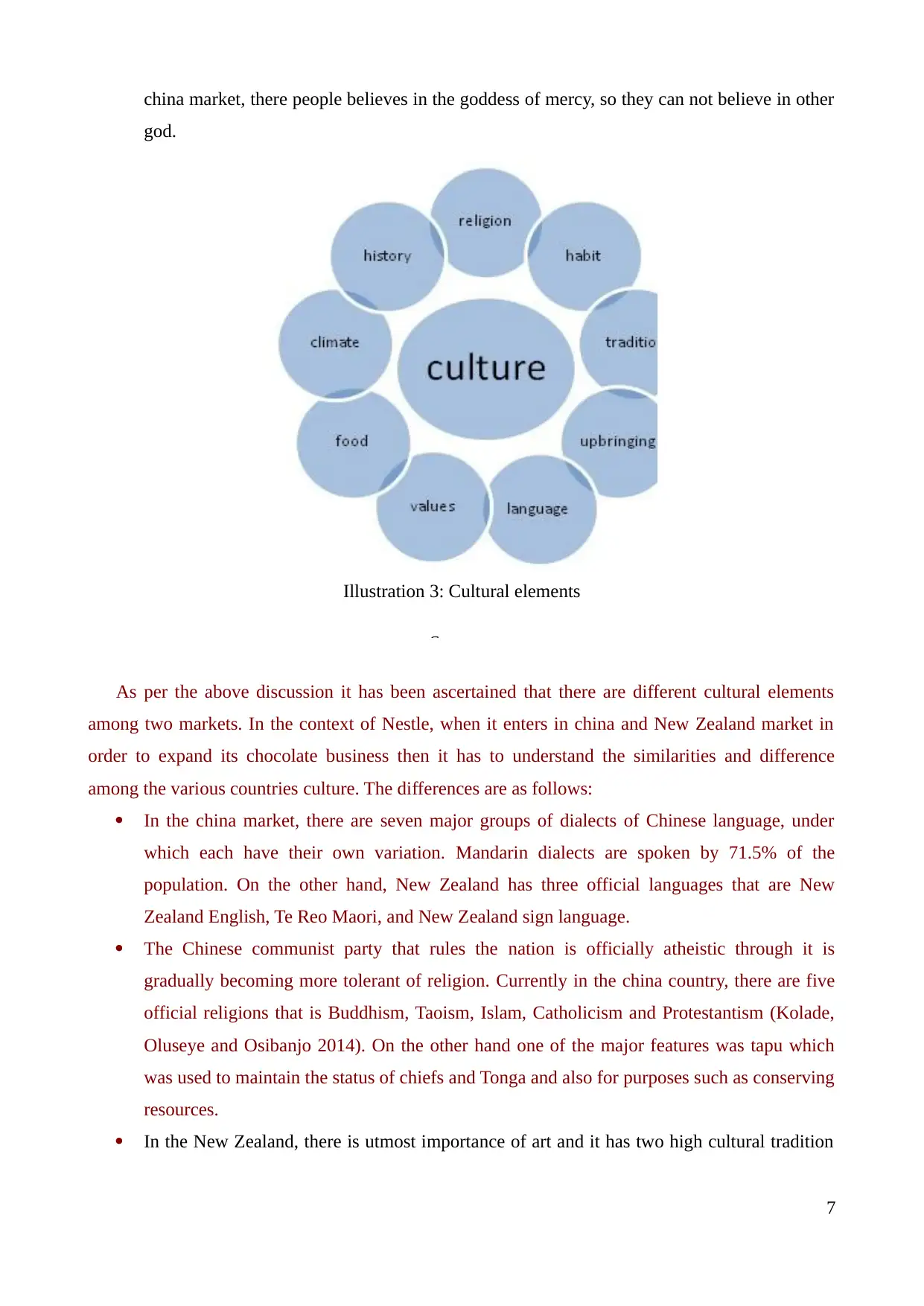
china market, there people believes in the goddess of mercy, so they can not believe in other
god.
Illustration 3: Cultural elements
Sources:
As per the above discussion it has been ascertained that there are different cultural elements
among two markets. In the context of Nestle, when it enters in china and New Zealand market in
order to expand its chocolate business then it has to understand the similarities and difference
among the various countries culture. The differences are as follows:
In the china market, there are seven major groups of dialects of Chinese language, under
which each have their own variation. Mandarin dialects are spoken by 71.5% of the
population. On the other hand, New Zealand has three official languages that are New
Zealand English, Te Reo Maori, and New Zealand sign language.
The Chinese communist party that rules the nation is officially atheistic through it is
gradually becoming more tolerant of religion. Currently in the china country, there are five
official religions that is Buddhism, Taoism, Islam, Catholicism and Protestantism (Kolade,
Oluseye and Osibanjo 2014). On the other hand one of the major features was tapu which
was used to maintain the status of chiefs and Tonga and also for purposes such as conserving
resources.
In the New Zealand, there is utmost importance of art and it has two high cultural tradition
7
god.
Illustration 3: Cultural elements
Sources:
As per the above discussion it has been ascertained that there are different cultural elements
among two markets. In the context of Nestle, when it enters in china and New Zealand market in
order to expand its chocolate business then it has to understand the similarities and difference
among the various countries culture. The differences are as follows:
In the china market, there are seven major groups of dialects of Chinese language, under
which each have their own variation. Mandarin dialects are spoken by 71.5% of the
population. On the other hand, New Zealand has three official languages that are New
Zealand English, Te Reo Maori, and New Zealand sign language.
The Chinese communist party that rules the nation is officially atheistic through it is
gradually becoming more tolerant of religion. Currently in the china country, there are five
official religions that is Buddhism, Taoism, Islam, Catholicism and Protestantism (Kolade,
Oluseye and Osibanjo 2014). On the other hand one of the major features was tapu which
was used to maintain the status of chiefs and Tonga and also for purposes such as conserving
resources.
In the New Zealand, there is utmost importance of art and it has two high cultural tradition
7
Paraphrase This Document
Need a fresh take? Get an instant paraphrase of this document with our AI Paraphraser
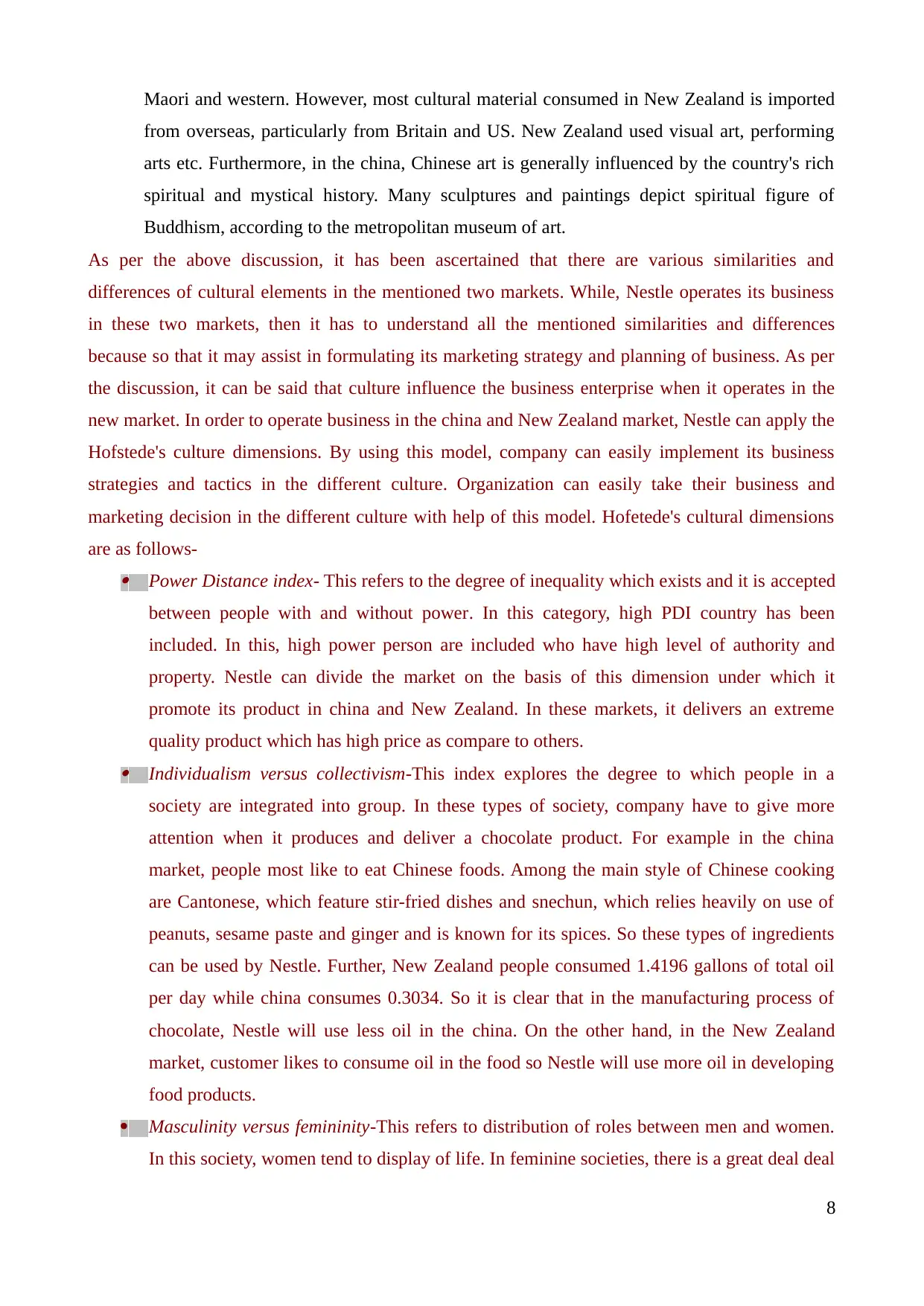
Maori and western. However, most cultural material consumed in New Zealand is imported
from overseas, particularly from Britain and US. New Zealand used visual art, performing
arts etc. Furthermore, in the china, Chinese art is generally influenced by the country's rich
spiritual and mystical history. Many sculptures and paintings depict spiritual figure of
Buddhism, according to the metropolitan museum of art.
As per the above discussion, it has been ascertained that there are various similarities and
differences of cultural elements in the mentioned two markets. While, Nestle operates its business
in these two markets, then it has to understand all the mentioned similarities and differences
because so that it may assist in formulating its marketing strategy and planning of business. As per
the discussion, it can be said that culture influence the business enterprise when it operates in the
new market. In order to operate business in the china and New Zealand market, Nestle can apply the
Hofstede's culture dimensions. By using this model, company can easily implement its business
strategies and tactics in the different culture. Organization can easily take their business and
marketing decision in the different culture with help of this model. Hofetede's cultural dimensions
are as follows- Power Distance index- This refers to the degree of inequality which exists and it is accepted
between people with and without power. In this category, high PDI country has been
included. In this, high power person are included who have high level of authority and
property. Nestle can divide the market on the basis of this dimension under which it
promote its product in china and New Zealand. In these markets, it delivers an extreme
quality product which has high price as compare to others. Individualism versus collectivism-This index explores the degree to which people in a
society are integrated into group. In these types of society, company have to give more
attention when it produces and deliver a chocolate product. For example in the china
market, people most like to eat Chinese foods. Among the main style of Chinese cooking
are Cantonese, which feature stir-fried dishes and snechun, which relies heavily on use of
peanuts, sesame paste and ginger and is known for its spices. So these types of ingredients
can be used by Nestle. Further, New Zealand people consumed 1.4196 gallons of total oil
per day while china consumes 0.3034. So it is clear that in the manufacturing process of
chocolate, Nestle will use less oil in the china. On the other hand, in the New Zealand
market, customer likes to consume oil in the food so Nestle will use more oil in developing
food products.
Masculinity versus femininity-This refers to distribution of roles between men and women.
In this society, women tend to display of life. In feminine societies, there is a great deal deal
8
from overseas, particularly from Britain and US. New Zealand used visual art, performing
arts etc. Furthermore, in the china, Chinese art is generally influenced by the country's rich
spiritual and mystical history. Many sculptures and paintings depict spiritual figure of
Buddhism, according to the metropolitan museum of art.
As per the above discussion, it has been ascertained that there are various similarities and
differences of cultural elements in the mentioned two markets. While, Nestle operates its business
in these two markets, then it has to understand all the mentioned similarities and differences
because so that it may assist in formulating its marketing strategy and planning of business. As per
the discussion, it can be said that culture influence the business enterprise when it operates in the
new market. In order to operate business in the china and New Zealand market, Nestle can apply the
Hofstede's culture dimensions. By using this model, company can easily implement its business
strategies and tactics in the different culture. Organization can easily take their business and
marketing decision in the different culture with help of this model. Hofetede's cultural dimensions
are as follows- Power Distance index- This refers to the degree of inequality which exists and it is accepted
between people with and without power. In this category, high PDI country has been
included. In this, high power person are included who have high level of authority and
property. Nestle can divide the market on the basis of this dimension under which it
promote its product in china and New Zealand. In these markets, it delivers an extreme
quality product which has high price as compare to others. Individualism versus collectivism-This index explores the degree to which people in a
society are integrated into group. In these types of society, company have to give more
attention when it produces and deliver a chocolate product. For example in the china
market, people most like to eat Chinese foods. Among the main style of Chinese cooking
are Cantonese, which feature stir-fried dishes and snechun, which relies heavily on use of
peanuts, sesame paste and ginger and is known for its spices. So these types of ingredients
can be used by Nestle. Further, New Zealand people consumed 1.4196 gallons of total oil
per day while china consumes 0.3034. So it is clear that in the manufacturing process of
chocolate, Nestle will use less oil in the china. On the other hand, in the New Zealand
market, customer likes to consume oil in the food so Nestle will use more oil in developing
food products.
Masculinity versus femininity-This refers to distribution of roles between men and women.
In this society, women tend to display of life. In feminine societies, there is a great deal deal
8
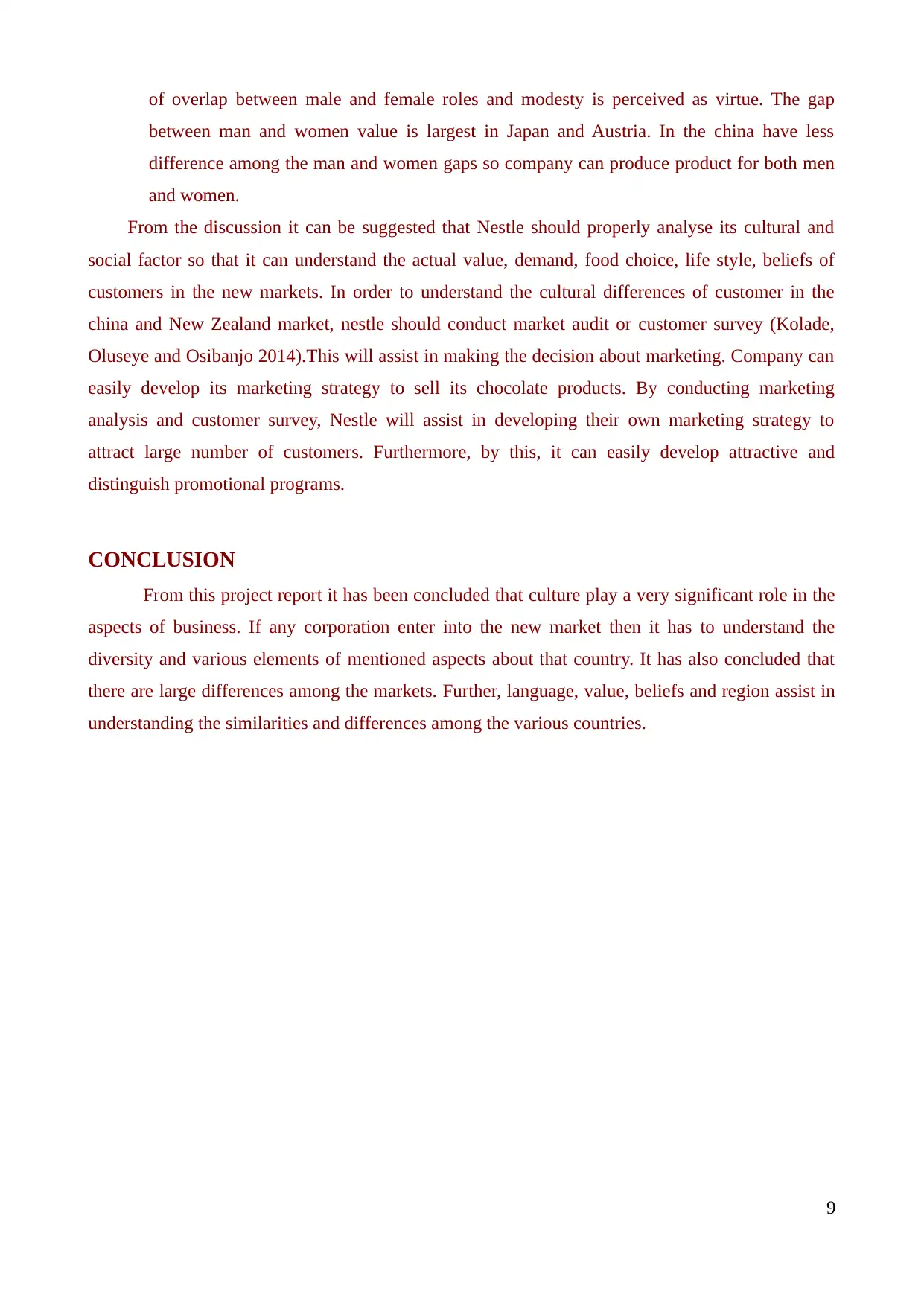
of overlap between male and female roles and modesty is perceived as virtue. The gap
between man and women value is largest in Japan and Austria. In the china have less
difference among the man and women gaps so company can produce product for both men
and women.
From the discussion it can be suggested that Nestle should properly analyse its cultural and
social factor so that it can understand the actual value, demand, food choice, life style, beliefs of
customers in the new markets. In order to understand the cultural differences of customer in the
china and New Zealand market, nestle should conduct market audit or customer survey (Kolade,
Oluseye and Osibanjo 2014).This will assist in making the decision about marketing. Company can
easily develop its marketing strategy to sell its chocolate products. By conducting marketing
analysis and customer survey, Nestle will assist in developing their own marketing strategy to
attract large number of customers. Furthermore, by this, it can easily develop attractive and
distinguish promotional programs.
CONCLUSION
From this project report it has been concluded that culture play a very significant role in the
aspects of business. If any corporation enter into the new market then it has to understand the
diversity and various elements of mentioned aspects about that country. It has also concluded that
there are large differences among the markets. Further, language, value, beliefs and region assist in
understanding the similarities and differences among the various countries.
9
between man and women value is largest in Japan and Austria. In the china have less
difference among the man and women gaps so company can produce product for both men
and women.
From the discussion it can be suggested that Nestle should properly analyse its cultural and
social factor so that it can understand the actual value, demand, food choice, life style, beliefs of
customers in the new markets. In order to understand the cultural differences of customer in the
china and New Zealand market, nestle should conduct market audit or customer survey (Kolade,
Oluseye and Osibanjo 2014).This will assist in making the decision about marketing. Company can
easily develop its marketing strategy to sell its chocolate products. By conducting marketing
analysis and customer survey, Nestle will assist in developing their own marketing strategy to
attract large number of customers. Furthermore, by this, it can easily develop attractive and
distinguish promotional programs.
CONCLUSION
From this project report it has been concluded that culture play a very significant role in the
aspects of business. If any corporation enter into the new market then it has to understand the
diversity and various elements of mentioned aspects about that country. It has also concluded that
there are large differences among the markets. Further, language, value, beliefs and region assist in
understanding the similarities and differences among the various countries.
9
⊘ This is a preview!⊘
Do you want full access?
Subscribe today to unlock all pages.

Trusted by 1+ million students worldwide
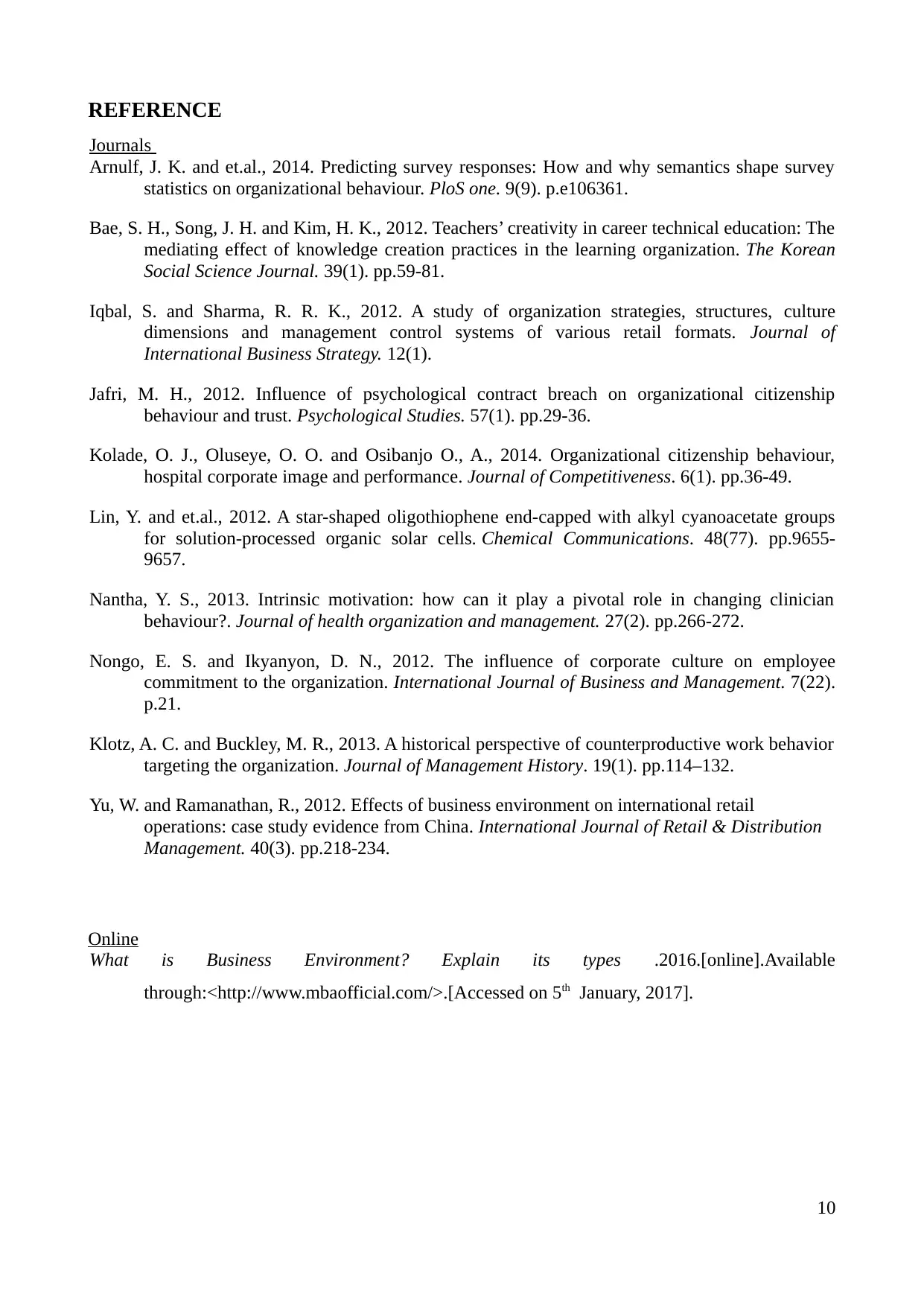
REFERENCE
Journals
Arnulf, J. K. and et.al., 2014. Predicting survey responses: How and why semantics shape survey
statistics on organizational behaviour. PloS one. 9(9). p.e106361.
Bae, S. H., Song, J. H. and Kim, H. K., 2012. Teachers’ creativity in career technical education: The
mediating effect of knowledge creation practices in the learning organization. The Korean
Social Science Journal. 39(1). pp.59-81.
Iqbal, S. and Sharma, R. R. K., 2012. A study of organization strategies, structures, culture
dimensions and management control systems of various retail formats. Journal of
International Business Strategy. 12(1).
Jafri, M. H., 2012. Influence of psychological contract breach on organizational citizenship
behaviour and trust. Psychological Studies. 57(1). pp.29-36.
Kolade, O. J., Oluseye, O. O. and Osibanjo O., A., 2014. Organizational citizenship behaviour,
hospital corporate image and performance. Journal of Competitiveness. 6(1). pp.36-49.
Lin, Y. and et.al., 2012. A star-shaped oligothiophene end-capped with alkyl cyanoacetate groups
for solution-processed organic solar cells. Chemical Communications. 48(77). pp.9655-
9657.
Nantha, Y. S., 2013. Intrinsic motivation: how can it play a pivotal role in changing clinician
behaviour?. Journal of health organization and management. 27(2). pp.266-272.
Nongo, E. S. and Ikyanyon, D. N., 2012. The influence of corporate culture on employee
commitment to the organization. International Journal of Business and Management. 7(22).
p.21.
Klotz, A. C. and Buckley, M. R., 2013. A historical perspective of counterproductive work behavior
targeting the organization. Journal of Management History. 19(1). pp.114–132.
Yu, W. and Ramanathan, R., 2012. Effects of business environment on international retail
operations: case study evidence from China. International Journal of Retail & Distribution
Management. 40(3). pp.218-234.
Online
What is Business Environment? Explain its types .2016.[online].Available
through:<http://www.mbaofficial.com/>.[Accessed on 5th January, 2017].
10
Journals
Arnulf, J. K. and et.al., 2014. Predicting survey responses: How and why semantics shape survey
statistics on organizational behaviour. PloS one. 9(9). p.e106361.
Bae, S. H., Song, J. H. and Kim, H. K., 2012. Teachers’ creativity in career technical education: The
mediating effect of knowledge creation practices in the learning organization. The Korean
Social Science Journal. 39(1). pp.59-81.
Iqbal, S. and Sharma, R. R. K., 2012. A study of organization strategies, structures, culture
dimensions and management control systems of various retail formats. Journal of
International Business Strategy. 12(1).
Jafri, M. H., 2012. Influence of psychological contract breach on organizational citizenship
behaviour and trust. Psychological Studies. 57(1). pp.29-36.
Kolade, O. J., Oluseye, O. O. and Osibanjo O., A., 2014. Organizational citizenship behaviour,
hospital corporate image and performance. Journal of Competitiveness. 6(1). pp.36-49.
Lin, Y. and et.al., 2012. A star-shaped oligothiophene end-capped with alkyl cyanoacetate groups
for solution-processed organic solar cells. Chemical Communications. 48(77). pp.9655-
9657.
Nantha, Y. S., 2013. Intrinsic motivation: how can it play a pivotal role in changing clinician
behaviour?. Journal of health organization and management. 27(2). pp.266-272.
Nongo, E. S. and Ikyanyon, D. N., 2012. The influence of corporate culture on employee
commitment to the organization. International Journal of Business and Management. 7(22).
p.21.
Klotz, A. C. and Buckley, M. R., 2013. A historical perspective of counterproductive work behavior
targeting the organization. Journal of Management History. 19(1). pp.114–132.
Yu, W. and Ramanathan, R., 2012. Effects of business environment on international retail
operations: case study evidence from China. International Journal of Retail & Distribution
Management. 40(3). pp.218-234.
Online
What is Business Environment? Explain its types .2016.[online].Available
through:<http://www.mbaofficial.com/>.[Accessed on 5th January, 2017].
10
1 out of 10
Related Documents
Your All-in-One AI-Powered Toolkit for Academic Success.
+13062052269
info@desklib.com
Available 24*7 on WhatsApp / Email
![[object Object]](/_next/static/media/star-bottom.7253800d.svg)
Unlock your academic potential
Copyright © 2020–2025 A2Z Services. All Rights Reserved. Developed and managed by ZUCOL.





